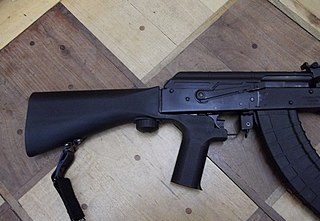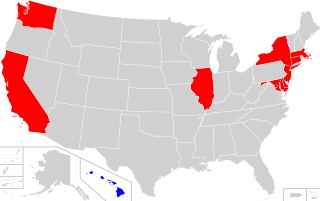Related Research Articles

A firearm is any type of gun that uses an explosive charge and is designed to be readily carried and used by an individual. The term is legally defined further in different countries.

A muzzle brake or recoil compensator is a device connected to, or a feature integral to the construction of, the muzzle or barrel of a firearm or cannon that is intended to redirect a portion of propellant gases to counter recoil and unwanted muzzle rise. Barrels with an integral muzzle brake are often said to be ported.

The National Firearms Act (NFA), 73rd Congress, Sess. 2, ch. 757, 48 Stat. 1236 was enacted on June 26, 1934, and currently codified and amended as I.R.C. ch. 53. The law is an Act of Congress in the United States that, in general, imposes an excise tax on the manufacture and transfer of certain firearms and mandates the registration of those firearms. The NFA is also referred to as Title II of the federal firearms laws, with the Gun Control Act of 1968 ("GCA") as Title I.

An automatic firearm or fully automatic firearm is a self-loading firearm that continuously chambers and fires rounds when the trigger mechanism is actuated. The action of an automatic firearm is capable of harvesting the excess energy released from a previous discharge to feed a new ammunition round into the chamber, and then igniting the propellant and discharging the projectile by delivering a hammer or striker impact on the primer.
A hell-fire trigger is a device that allows a semi-automatic firearm to fire at an increased rate. The hell-fire clamps to the trigger guard behind the trigger and presses a "finger" against the back of the trigger to increase the force that returns the trigger to its forward position, effectively decreasing the time required for the trigger to reset, allowing for a faster follow up shot.

A firearm is said to fire from an open bolt or open breech if, when ready to fire, the bolt and working parts are held to the rear of the receiver, with no round in the chamber. When the trigger is actuated, the bolt travels forward, feeds a cartridge from the magazine or belt into the chamber, and fires that cartridge in the same movement. Like any other self-loading design, the action is cycled by the energy released from the propellant, which sends the bolt back to the rear, compressing the mainspring in readiness for firing the next round. In an open-bolt gun firing semi-automatically, the bolt is caught and held at this point by the sear after each shot; and in automatic open-bolt fire, it's caught and held in this manner whenever the trigger is released. In contrast to this, in closed-bolt guns, the trigger and sear do not affect the movement of the bolt directly.
A gunstock or often simply stock, the back portion of which is also known as a shoulder stock, a buttstock, or simply a butt, is a part of a long gun that provides structural support, to which the barrel, action, and firing mechanism are attached. The stock also provides a means for the shooter to firmly brace the gun and easily aim with stability by being held against the user's shoulder when shooting the gun, and helps to counter muzzle rise by transmitting recoil straight into the shooter's body.

Bump stocks or bump fire stocks are gun stocks that can be used to assist in bump firing, the act of using the recoil of a semi-automatic firearm to fire ammunition cartridges in rapid succession.

Short-barreled rifle broadly refers to any rifle with an unusually short barrel. The term carbine describes a production rifle with a reduced barrel length for easier handling in confined spaces. Concern about concealment for illegal purposes has encouraged regulations specifying minimum barrel lengths and overall lengths.

Title II weapons, or NFA firearms, are designations of certain weapons under the United States National Firearms Act (NFA).
The Sputter Gun was a prototype test gun using 7 major components from the WW2 era British Sten submachine gun carbine, along with other specially fabricated parts to make a complete operational firearm. It was designed to circumvent the existing U.S. Federal law defining a machine gun. The Sputter Gun, lacking any trigger, was designed to fire multiple rounds automatically, upon release of the bolt from its safety slot, until all ammunition was expended from the magazine.

Gun laws in Florida regulate the sale, possession, and use of firearms and ammunition in the state of Florida in the United States.

An AR-15–style rifle is a lightweight semi-automatic rifle based on or similar to the Colt AR-15 design. The Colt model removed the selective fire feature of its predecessor, the original ArmaLite AR-15, itself a scaled-down derivative of the AR-10 design by Eugene Stoner. It is closely related to the military M16 rifle.

Assault weapons legislation in the United States refers to bills and laws that define and restrict or make illegal the manufacture, transfer, and possession of assault weapons. How these firearms are defined and regulated varies from jurisdiction to jurisdiction; generally, this constitutes a list of specific firearms and combinations of features on semiautomatic firearms.

The SIG MPX is a gas-operated submachine gun designed and manufactured by SIG Sauer, and is primarily chambered in 9×19mm Parabellum. It is a gas-operated firearm featuring a closed, rotating bolt. These design features, rare in submachine guns, were chosen to enhance the safety of the user and to have a more reliable firearm. It was designed in 2013 and was released to the general public in 2015. It features the SIG Sauer short stroke push-rod gas system to reduce the recoil and improve the reliability of the weapon.

A privately made firearm is a legal term for a firearm produced by a private individual as opposed to a corporate or government entity. The term "ghost gun" is used mostly in the United States by gun control advocates, but it is being adopted by gun rights advocates and the firearm industry because of recent regulations adopted by the Bureau of Alcohol, Tobacco, Firearms and Explosives.

A switch or Glock auto-sear is a small device that can be attached to the rear of the slide of a Glock handgun, converting the semi-automatic pistol into a machine pistol capable of fully automatic fire. As a type of auto sear, it functions by applying force to the trigger bar to prevent it from limiting fire to one round of ammunition per trigger pull. This device by itself, regardless if it is installed on a slide or not, is considered by the Bureau of Alcohol, Tobacco, Firearms and Explosives (ATF) to be a machine gun, making possession of the device illegal in the United States under most circumstances.
A trigger crank is a device that allows a semi-automatic firearm to fire at an increased rate. The trigger crank typically consists of a screw-tight clamp and crank assembly. The crank assembly is clamped onto the trigger guard of a semi-automatic firearm. The device is positioned in front of the trigger. When the crank is turned, tiny gears depress the trigger and cause the weapon to fire.

A forced reset trigger is a device that allows a person to fire a semi-automatic firearm at an increased rate. The forced reset trigger works by mechanically resetting the trigger's position after a shot is fired. This allows for an increased rate of fire. However, the shooter must still manually pull the trigger each time it resets for any subsequent shot to be fired.
On February 18, 2024, during a police standoff in Burnsville, Minnesota, United States, Shannon Gooden shot and killed police officers Paul Elmstrand and Matthew Ruge and firefighter-paramedic Adam Finseth. Another police officer was injured by gunfire. After firing at the first responders, Gooden killed himself with a single, self-inflicted gunshot wound to the head. The officers were responding to a 911 call that reported an alleged sexual assault. Federal authorities alleged that the weapons Gooden used were obtained illegally via straw purchase and filed criminal charges against his girlfriend.
References
- ↑ Griffith, Earl (November 20, 2013). "Echo Approval Letter" (PDF). ATF. Archived from the original (PDF) on May 31, 2023. Retrieved May 31, 2023– via Violence Policy Center.
- ↑ "Ruger Two Shot Trigger". ATF. January 20, 2004. Archived from the original on May 31, 2023. Retrieved May 31, 2023– via Photobucket.
- ↑ "Rulings". ATF.gov. ATF. September 23, 2022. Archived from the original on May 31, 2023. Retrieved May 31, 2023.
- ↑ Yablon, Alex (October 16, 2017). "These Six Barely Legal Gun Products Are Still Widely Available". The Trace .
- ↑ Eaton, Joshua (June 18, 2018). "Gunmakers have the successor to the bump stock lined up". ThinkProgress. Archived from the original on May 31, 2023. Retrieved May 31, 2023.
- ↑ "In wake of Burnsville shooting, Minnesota Legislature discusses increasing penalties for straw gun purchases".